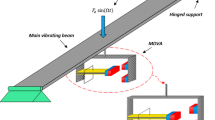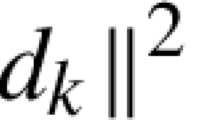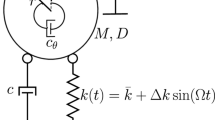Abstract
The Gibbs phenomenon describes oscillations of small or large amplitudes that occur, when a signal with steep gradients or noise components is approximated. Such interruptions can degrade the quality of desired signal. Reduction of such oscillations is an essential task to extract vital information from the desired signal. This paper, therefore, presents the Chebyshev spectral method (CSM) that is combined with two novel concepts to reduce the influence of oscillatory structures. The first notion uses a thresholding approach to estimate true expansion coefficients in a noisy environment, while the second concept introduces a new smoothing function. The basic framework of the proposed concept is to introduce an additional threshold procedure into pre-existing Chebyshev collocation method to handle the fluctuations of noise interferences. Moreover, the CSM is the global-behaviour approximation based on the points of an entire domain, which allows for high-order convergence to be recovered. The method is implemented for sharp gradient-contained function and to a signal that has been distorted by noise. Through computational experiments, efficiency of the proposed method is verified graphically and numerically. Signal-to-noise ratio of 37.4810 dB is achieved with corresponding mean square error about 1.79e−04. The percentage root-mean-square difference (PRD) and maximum error are obtained as 1.3402% and 0.0399, respectively.











Similar content being viewed by others
Availability of data and materials
For this work, the authors have not used any data.
References
R. Archibald, A. Gelb, A method to reduce the Gibbs ringing artifact in MRI scans while keeping tissue boundary integrity. IEEE Trans. Med. Imaging 21(4), 305–319 (2002)
L.K. Balyan, A.K. Mittal, M. Kumar, M. Choube, Stability analysis and highly accurate numerical approximation of Fisher’s equations using pseudospectral method. Math. Comput. Simul. 117, 86–104 (2020)
L.K. Balyan, P. Dutt, R.K.S. Rathore, Least squares h-p spectral element methods for elliptic eigenvalue problems. Appl. Math. Comp. 218(19), 9596–9613 (2012)
J.P. Boyd, Chebyshev and Fourier Spectral Methods (Dover, New York, 2001)
C.W. Clenshaw, H.J. Norton, The solution of nonlinear ordinary differential equations in Chebyshev Series. Comput. J. 6, 88–92 (1963)
C. Canuto, M.Y. Hussaini, A. Quarteroni, T.A. Zang, Spectral Methods in Fluid Dynamics (Springer, New York, 1988)
S.G. Chang, B. Yu, M. Vetterli, Adaptive wavelet thresholding for image de-noising and compression. IEEE Trans. Image Process. 9(9), 1532–1546 (2000)
P.R. Clement, On Completeness of basis functions used for signal analysis. SIAM Rev. 5(2), 131–139 (1963)
A.E. Cetin, M. Tofighi, Denosing using wavelets and projections onto the 11-ball. ArXiv e-prints 1406.2528 (2014).
D.L. Donoho, Denoising via soft thresholding. IEEE Trans. Inf. Theory 41, 613–627 (1995)
D.L. Donoho, I.M. Johnstone, Adapting to unknown smoothness via wavelet shrinkage. J. Am. Stat. Assoc. 90(432), 1200–1224 (1995)
T.H. Fay, K.G. Schulz, The Gibbs’ phenomenon from a signal processing point of view. Int. J. Math. Educ. Sci. Technol. 32(6), 863–872 (2001)
D. Gottlieb, C.W. Shu, A. Solononoff, H. Vandeven, On the Gibbs phenomenon I: recovering exponential accuracy from the Fourier partial sum of a non-periodic analytical function. J. Comput. Appl. Math. 43, 81–98 (1992)
D. Gottlieb, C.-W. Shu, On the Gibbs phenomenon and its resolution. SIAM Rev. 39(4), 644–668 (1997)
P. Grandclement, Introduction to spectral methods. EAS Publ. Ser. 21, 153–180 (2006)
D. Gottlieb, S.A. Orszag, Numerical Analysis of Spectral Methods: Theory and Applications, vol. 26 (SIAM, Philadelphia, 1977)
D. Gottlieb, J.S. Hestaven, Spectral methods for hyperbolic problems. J. Comput. Appl. Math. 128, 83–131 (2001)
F.J. Harris, On the use of windows for harmonic analysis with the discrete Fourier transform. Proc. IEEE 66, 51–83 (1978)
J. Hesthaven, R. Kirby, Filtering in Legendre spectral methods. Math. Comput. 77(263), 1425–1452 (2008)
J.S. Hesthaven, S. Gottlieb, D. Gottlieb, Spectral Methods for Time-Dependent Problems, vol. 21 (Cambridge University Press, Cambridge, 2007)
E. Hewitt, R.E. Hewitt, The Gibbs-Wilbraham phenomenon: an episode in Fourier analysis. Arch. Hist. Exact Sci. 21(2), 129–160 (1979)
V.K. Ingle, J.G. Proakis, Digital Signal Processing Using MATLAB: A Problem Solving Companion (Cengage Learning, Boston, 2016)
A. J. Jerri, The Gibbs phenomenon in Fourier analysis. Splines and Wavelet Approxima (1998)
D. Kosloff, H. Tal-Ezer, A modified Chebyshev pseudospectral method with an time step restriction. J. Comput. Phys. 104, 457–469 (1993)
H.O. Kreiss, J. Oliger, Stability of Fourier methods. SIAM J. Numer. Anal. 16, 421–433 (1979)
A. Kumar, G.K. Singh, R. Anand, A simple design method for the cosine-modulated filter banks using weighted constrained least square technique. J. Franklin Inst. 348(4), 606–621 (2011)
C.L. Lanczos, Trigonometric Interpolation of Empirical and Analytic Functions. J. Math. Phys. 17, 123–199 (1938)
A.A. Michelson, S.W. Stratton, Vi. a new harmonic analyser. Lond. Edinb. Dublin Philos. Mag. J. Sci. 45(272), 85–91 (1898)
R. L. Mace, Reduction of the Gibbs Phenomenon via Interpolation Using Chebyshev Polynomials, Filtering and Chebyshev-Pade’ Approximations. Theses, Dissertations and Capstones, Paper 717 (2005).
S.K. Mitra, Y. Kuo, Digital Signal Processing: A Computer-Based Approach, vol. 2 (McGraw-Hill, New York, 2006)
M. Niedzwiecki, W.A. Sethares, Smoothing of discontinuous signals: the competitive approach. IEEE Trans. Signal Processing 43(1), 1–12 (1995)
A. Oppenheim, A. Willsky, I. Young, Signals and Systems (Prentice Hall, New York, 1983)
K.M. Prabhu, Window Functions and Their Applications in Signal Processing (CRC Press, New York, 2013)
H. Rakshit, M. A. Ullah, A comparative study on window functions for designing efficient fir filter, in 2014 9th International Forum on Strategic Technology (IFOST). IEEE, pp. 91–96 (2014)
J. Shen, T. Tang, L. L. Wang, Orthogonal polynomials and related approximation results, in Spectral Methods. Springer Series in Computational Mathematics, vol. 41. Springer, Berlin (2011)
J.C. Slater, Electronic energy bands in metal. Phys. Rev. 45, 794–801 (1934)
L. N. Trefethen, Finite difference and spectral methods for ordinary and partial differential equations. Unpublished text, available at http://web.comlab.ox.ac.uk/oucl/work/nick.trefethen/pdetext.html (1996).
E. Tadmor, The exponential accuracy of Fourier and Chebyshev differencing methods. SIAM J. Numer. Anal. 23, 1–10 (1986)
E. Tadmor, Filters, mollifiers and the computation of the Gibbs phenomenon. Acta Numer 16, 305 (2007)
F. Ustina, Henry Wilbraham and Gibbs phenomenon in 1848. Hist. Math. 1(1), 83–84 (1974)
H. Wilbraham, On a certain periodic function. Cambridge Dublin Math. J. 3, 198–201 (1848)
K. Wright, Chebyshev collocation methods for ordinary differential equations. Comput. J. 6, 358–365 (1964)
H. Zhu, M. Ding, Y. Li, Gibbs phenomenon for fractional Fourier series. IET Signal Proc. 5(8), 728–738 (2011)
Funding
There is no funding organization for the supporting distribution.
Author information
Authors and Affiliations
Corresponding author
Ethics declarations
Conflict of interest
None.
Additional information
Publisher's Note
Springer Nature remains neutral with regard to jurisdictional claims in published maps and institutional affiliations.
Appendices
Appendix
Theorem: A.1: Accuracy of Chebyshev polynomial interpolation on unequally spaced points [38]
Let \(\phi\) be a function that belongs to \({\mathcal{H}}\) Hilbert space and \(\left\{ {\varsigma_{j}^{{\prime }} s} \right\}\) are the interpolation points that follows the density function given by Eq. (11). Assume \(N > 0\), for any \(N\epsilon {\mathbb{Z}}\), there exists an interpolation polynomial \(P_{N} \phi\) based on Chebyshev polynomials, which coincides with \(\phi\) exactly at \(\left\{ {\varsigma_{j}^{{\prime }} s} \right\}\). Correspondingly, the electrostatic potential is given as:
And defines the supremum of potential
If \(\exists\) is an upper bound such that \(z^{{{\text{constt}}}} > z^{\sup }\), in a closed domain \(\left\{ {\zeta \epsilon {\mathbb{C}}: z\left( \varsigma \right) \le z^{{{\text{constt}}}} } \right\}, {\text{then}}\,\,\exists\) is a constant \(A > 0\), such that for each \(N\)
for all \(\varsigma \epsilon \left[ { - 1,1} \right].\)
Rights and permissions
About this article
Cite this article
Saini, P., Balyan, L.K., Kumar, A. et al. Modification of Chebyshev Pseudospectral Method to Minimize the Gibbs Oscillatory Behaviour in Resynthesizing Process. Circuits Syst Signal Process 41, 6238–6265 (2022). https://doi.org/10.1007/s00034-022-02081-9
Received:
Revised:
Accepted:
Published:
Issue Date:
DOI: https://doi.org/10.1007/s00034-022-02081-9




